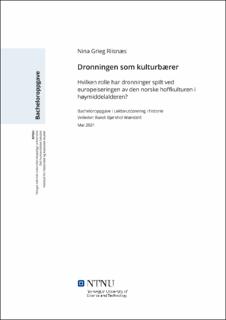| dc.contributor.advisor | Wærdahl, Randi Bjørshol | |
| dc.contributor.author | Riisnæs, Nina Grieg | |
| dc.date.accessioned | 2021-09-13T16:09:30Z | |
| dc.date.available | 2021-09-13T16:09:30Z | |
| dc.date.issued | 2021 | |
| dc.identifier | no.ntnu:inspera:80117600:37681620 | |
| dc.identifier.uri | https://hdl.handle.net/11250/2775760 | |
| dc.description.abstract | Temaet for denne fordypningsoppgaven er europeiseringsprosessen, og hvordan dronningene har påvirket og blitt påvirket av denne. Fra midten av det 13. århundret sto det norske hoffet som en mottaker for en stor kulturell innstrømming fra kontinentaleuropa. Tidligere forskning viser markante endringer knyttet til skikker, språk, klesdrakter, og litteratur, sammen med en opphøyning av hoffets posisjon og et økt fokus på pomp, prakt, festligheter og seremonier. Oppgaven undersøker dronningenes innflytelse på og påvirkning av denne prosessen. Problemstillingen lyder følgelig:
Hvilken rolle har dronninger spilt ved europeiseringen av den norske hoffkulturen i høymiddelalderen?
For å svare på denne problemstillingen har jeg analysert innflytelsen til dronningene Margrete Skulesdatter, Margrete Alexandersdatter, Isabella Bruce, Eufemia av Rügen, og Blanka av Namur, da disse var dronninger i den perioden man ser de mest markante kulturelle endringene hos det norske hoffet. Ved å undersøke dronningenes bruk og overføring av europeisk litteratur, skikker, språk og klesdrakter, har jeg vurdert hvilken grad av innflytelse de ulike dronningene kan ha hatt på europeiseringsprosessen. Oppgaven innehar også en undersøkelse av hvordan elementer som ble innført som følge av europeiseringen, slikt som kroningsseremonien og hoffets opphøyde rolle, har bidratt til å endre dronningenes posisjon i et kulturelt perspektiv. Undersøkelsene mine viser at dronningene har vært pådrivere for europeiseringen av hoffkulturen, men at graden av innflytelse naturligvis varierer avhengig av hvilken dronning man ser på. Videre viser oppgaven at europeiseringsprosessen brakte med seg elementer som har bidratt til å endre dronningens kulturelle rolle, og dette i forbindelse med kroningsseremonien og hoffets sterkere posisjon. | |
| dc.description.abstract | The topic of this paper is the Europeanisation process in Norway, and how the Norwegian queens have influenced, and been influenced, by it. From the middle of the 13th century the Norwegian court witnessed a large cultural influx from continental Europe. Previous research shows significant changes in customs, language, clothes, and literature. Along with this, the courts standing was raised together with an increase in finer aristocratic living, decorative clothing, festivities and ceremonies. This paper investigates the queens’ effect on this process, and how they were affected by it. The thesis statement is:
What role did queens have in the Europeanisation of the Norwegian court in the high medieval ages?
To answer the thesis, I have analysed the influence of the Norwegian queens: Margrete Skulesdatter, Margrete Alexandersdatter; Isabella Bruce, Eufemia of Rügen, and Blanka of Namur, given that these queens reigned in the period with the highest cultural changes at the Norwegian court. In researching the queens’ use and transfer of European literature, customs, language and clothing, I have assessed the degree of influence each of these queens may have caused on the Europeanisation process. The paper also assesses how elements of the euroization process, as coronation rituals and the heightening of the court, have changed the cultural role and importance of the queens. My research concludes that the queens have played an important part in the cultural changes, but that the extent naturally differs between them. This research also concludes that the heightening of the court, as well as coronation rituals, have changed the cultural role of the Norwegian queens. | |
| dc.language | nob | |
| dc.publisher | NTNU | |
| dc.title | Dronningen som kulturbærer | |
| dc.type | Bachelor thesis | |
